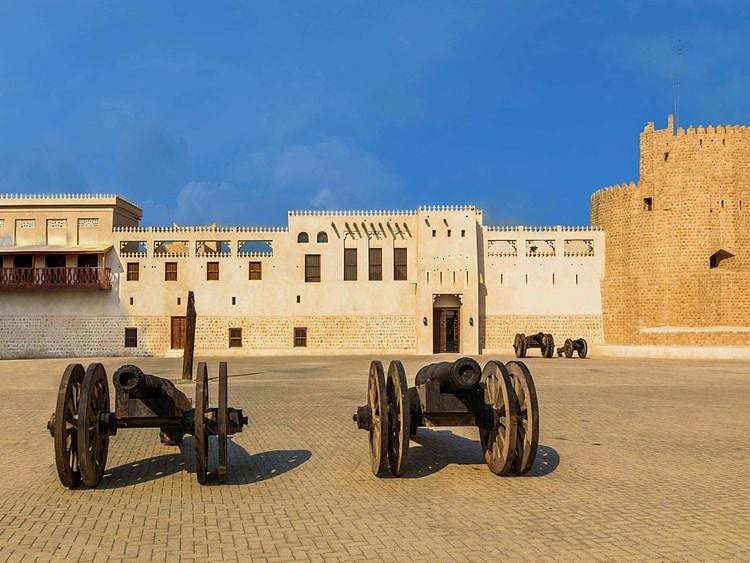How the 200-year-old Sharjah Fort has withstood the vagaries of time
There’s much to see, learn and do at the historic monument as it marks its bicentennial

Sharjah: When the Sharjah Fort was first built in 1823, it perhaps made perfect sense to use light brown plaster and coral stone for its construction as it was available in abundance in the Arabian Gulf. It’s intricately designed ceiling was also built with locally relevant palm fronds and mangrove tree columns. Two hundred years later, in what is a tribute to its rich history, the fort, which has withstood the vagaries of time, stands magnificent in all its restored glory.
Sharjah Museums Authority (SMA) has much to celebrate as is commemorates the bicentennial of the Sharjah Fort this year.
Throughout its history, the fort has faced many challenges, notably when His Highness Sheikh Dr. Sultan bin Mohammed Al Qasimi, Member of the Supreme Council and Ruler of Sharjah, learned during his 1969 studies in Egypt of its impending demolition.
According to the authorities, “This urgent news prompted his swift return to Sharjah to salvage the fort’s remains, which included a tower and two damaged walls. Rebuilding the fort was a vision close to the Sharjah Ruler’s heart as he retained the primary doors of the fort, including the main Al Sabah gate, and the Al Khazna gate for 28 years before he directed its reconstruction based on historical photographs.
History of Sharjah city
Once the restoration was finished, Sheikh Sultan enriched the fort with collections that chronicle the history of Sharjah city.
The fort boasts two levels, a spacious central courtyard, three defensive towers named Al-Mahlousa, Al-Kabis, and Musharraf Square and a primary balcony housing the repentance wood previously used to mete out punishments.
Its ground floor comprises the arrest room which has been transformed into a resting area, the Mahloussa prison, the armoury, and the Al Hisn gallery, detailing the building’s history and restoration phases.
Galleries with treasures
There is also the Madbasa Gallery where visitors can learn about the process of extracting date juice, commonly referred to as molasses, Al-Qawasim Gallery that provides insights into the history of Al-Qawasim and their encounters with both regional and foreign entities.
The upper level houses Sheikh Sultan bin Saqr II Gallery, the Al-Kabis Tower, the Weapons Gallery, the Sheikh’s Room, Al Ghurfa (a room dedicated for meeting esteemed guests), the balcony and the Majlis dedicated to showcasing historical documents and photographs.
As the SMA points out, the fort is home to an array of artefacts, including the main gate, the dancing cannon, the pearl magnifier, the royal bed, Marduf Al-Qawasim’s coin, letters from Somali royal beds, the Quran stand belonging to Sheikh Khalid bin Sultan Al Qasimi, the Qawasim’s flag, the occupation flag, the Naval Cannon, a pocket watch and the passport of Sheikh Sultan bin Saqr II.
It also houses the Al-Qawasim lineage chart and origins diagram, the Katara blade, Al-Shatfa headband and numerous other historical objects.
Many events
Sharjah Fort has been the venue for numerous events spearheaded by SMA. Among them is the yearly “Fortress in Memory” initiative through which the authority showcases Sharjah’s historic sites.
There is much to see, learn and do at the historic monument as events like ‘Al Hisn in Memory’ and ‘The Great Historical Monument’ discussion have demonstrated.
In February, the fort was brilliantly lit for the Sharjah Lights Festival 2023 and was the venue for the Haq Al Laila celebrations.
As the SMA states, “Two hundred years post its erection, having observed myriad historical shifts and serving as a sanctuary for the local populace and a centre for political, social and cultural endeavours, the fort remains a distinguished architectural gem. It resonates with immense historical significance, encapsulating the city’s timeless essence and its rich cultural lineage, drawing visitors from across the globe.”
National Day celebrations beckon
Entry to the Sharjah Fort will be free on December 1 and 2. A number of cultural and entertainment programmes will be held for visitors all ages in order to promote a deeper understanding of Sharjah’s modern history, the Ruling family, daily life in the emirate 200 years ago and the fort’s history and restoration leading to its official opening in 2015.
Sign up for the Daily Briefing
Get the latest news and updates straight to your inbox
Network Links
GN StoreDownload our app
© Al Nisr Publishing LLC 2025. All rights reserved.